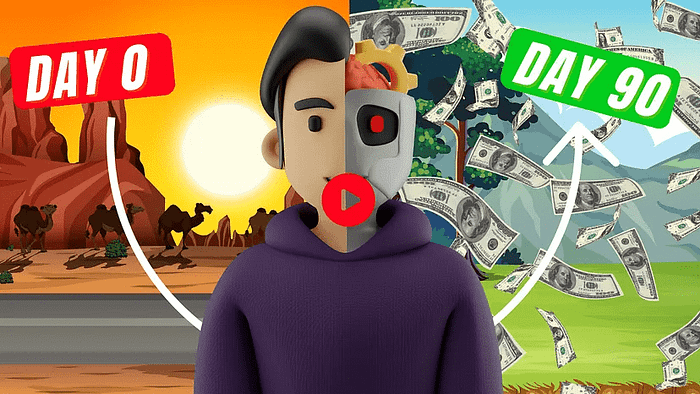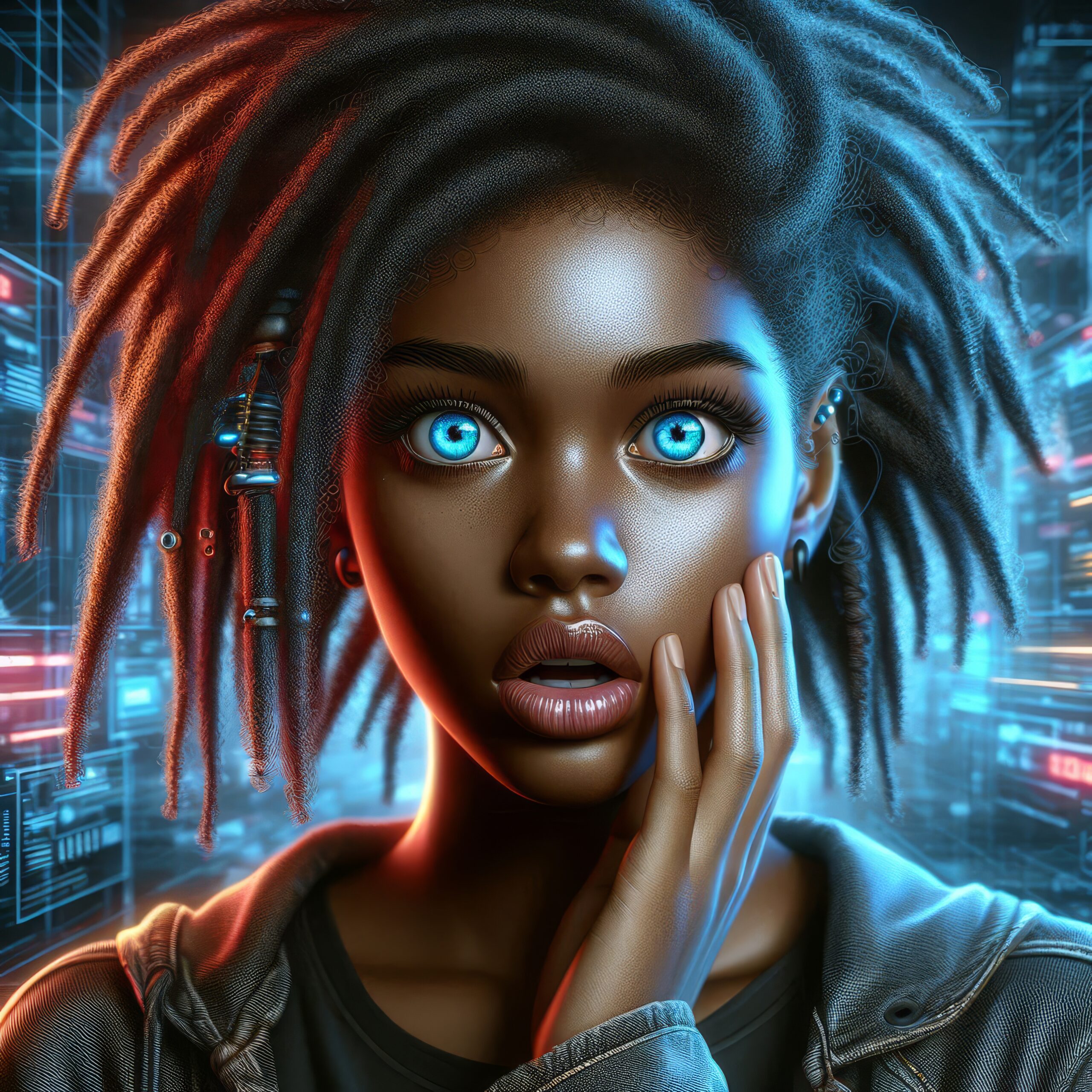I Tried an AI Side Hustle: Selling AI Generated Stock Photos Online
Venturing into the world of AI generated stock photos has been an eye-opening journey for me.
As someone always on the lookout for innovative ways to earn money online, I stumbled upon a fascinating opportunity that combines cutting-edge technology with creativity.
This blog post will take you through my personal experience of turning AI-generated imagery into a profitable side hustle.
From setting up accounts to navigating the intricacies of online marketplaces, I’ll share every step of my adventure in the realm of artificial intelligence and digital art.
Whether you’re a tech enthusiast, a budding entrepreneur, or simply curious about the intersection of AI and commerce, this story will provide valuable insights into a burgeoning industry.
So, buckle up as we explore the exciting world of selling AI generated stock photos online!
We strongly recommend that you check out our guide on how to take advantage of AI in today’s passive income economy.
Table of Contents
The Genesis of My AI Stock Photo Journey
Discovering the Potential
My foray into selling AI generated stock photos began with a simple online search.
I was exploring various side hustle options when I came across the concept of selling photos online.
As I delved deeper, I realized that the landscape of stock photography was evolving rapidly, with AI-generated content becoming increasingly prevalent.
This piqued my interest, as it seemed to offer a unique blend of creativity and technology.
The idea of creating and selling images without the need for professional photography equipment was intriguing.
I spent hours researching different platforms and reading success stories of individuals who had turned this into a profitable venture.
The more I learned about AI generated stock photos, the more excited I became about the possibilities.
Understanding the Market
Before diving headfirst into this new endeavor, I knew I needed to understand the market for AI generated stock photos.
I discovered that there was a growing demand for unique, diverse, and customizable imagery across various industries.
From marketing agencies to small businesses, many were turning to AI-generated content to meet their visual needs.
The flexibility and speed of AI image generation were major selling points.
Additionally, I found that the market was not yet saturated, providing ample opportunity for newcomers like myself.
This research phase was crucial in building my confidence and formulating a strategy for entering the world of AI stock photography.
Getting Started with AI Generated Stock Photos
Choosing the Right Platform
The first step in my journey was selecting the right platform to sell my AI generated stock photos.
After extensive research, I narrowed down my options to a few popular marketplaces specializing in stock imagery.
These platforms offered a wide reach and user-friendly interfaces for both creators and buyers.
I carefully compared their commission structures, submission guidelines, and overall reputation in the industry.
Ultimately, I decided to start with iStock (by Getty Images) due to its strong market presence and integration with other platforms.
This choice seemed to offer the best balance of exposure and earning potential for my AI generated stock photos.
Setting Up My Account
Once I had chosen my platform, the next step was setting up my account.
The process was straightforward, requiring basic personal information and agreeing to the platform’s terms and conditions.
I paid close attention to the guidelines for contributors, especially those pertaining to AI generated stock photos.
It was crucial to understand what types of content were acceptable and how to properly label and categorize my submissions.
After verifying my email and providing my address details, I was ready to start uploading my creations.
The platform offered a clean, intuitive dashboard that made navigating the various features a breeze.
Creating My First AI Generated Stock Photos
With my account set up, it was time to create my first batch of AI generated stock photos.
I experimented with various AI image generation tools, each offering unique features and styles.
The learning curve was steep at first, but I quickly became fascinated by the endless possibilities.
I focused on creating diverse images that could cater to different markets and industries.
From abstract backgrounds to realistic product mockups, I tried to build a varied portfolio.
The process of refining prompts and tweaking settings to achieve desired results was both challenging and rewarding.
Each successful image felt like a small victory, fueling my enthusiasm for this new creative endeavor.
The Art of Creating Marketable AI Generated Stock Photos
Understanding Buyer Needs
As I delved deeper into the world of AI generated stock photos, I realized the importance of understanding buyer needs.
It wasn’t just about creating visually appealing images; they needed to serve a purpose for potential customers.
I spent time analyzing trending topics, popular search terms, and in-demand visual styles on the platform.
This research helped me tailor my creations to meet market demands more effectively.
I also paid attention to seasonal trends and upcoming events that might influence buyer preferences.
By aligning my AI generated stock photos with these insights, I hoped to increase their marketability and appeal.
Mastering the Art of Prompts
Creating effective AI generated stock photos is as much about mastering the art of prompts as it is about the technology itself.
I learned that the quality and specificity of my prompts directly impacted the results I got.
I experimented with different phrasing, descriptors, and combinations to achieve the desired outcomes.
Sometimes, a small tweak in wording could lead to a dramatically different and more marketable image.
I started keeping a journal of successful prompts and techniques, building a personal library of effective approaches.
This process of refinement and experimentation became an enjoyable part of my creative workflow.
Ensuring Quality and Uniqueness
One of the challenges with AI generated stock photos is ensuring both quality and uniqueness.
I developed a rigorous review process for each image I created before submitting it to the platform.
This involved checking for any artifacts or inconsistencies that might detract from the image’s quality.
I also made sure each image was sufficiently different from others in my portfolio and on the platform.
Uniqueness was key to standing out in a crowded marketplace and avoiding potential copyright issues.
I found that combining different techniques and styles helped create truly one-of-a-kind AI generated stock photos.
Navigating the Submission Process
Understanding Platform Guidelines
Before submitting my AI generated stock photos, I thoroughly reviewed the platform’s submission guidelines.
Each marketplace has specific requirements for image quality, format, and metadata.
I paid special attention to any rules specific to AI-generated content, as these can differ from traditional stock photos.
Understanding these guidelines was crucial to avoid rejections and ensure a smooth submission process.
I created a checklist to ensure each of my AI generated stock photos met all the necessary criteria.
This attention to detail helped improve my acceptance rate and build a positive reputation on the platform.
Optimizing Metadata and Keywords
I quickly learned that the success of AI generated stock photos isn’t just about the images themselves.
Optimizing metadata and keywords plays a crucial role in making your content discoverable to potential buyers.
I developed a system for thoroughly describing each image, using relevant and specific keywords.
This process involved thinking from the buyer’s perspective: what terms might they use to search for this type of image?
I also made sure to include broader category terms as well as specific descriptors for each AI generated stock photo.
Balancing between popular keywords and niche terms helped improve the visibility of my portfolio.
Dealing with Rejections and Feedback
Despite my best efforts, not all of my AI generated stock photos were accepted on the first try.
Dealing with rejections was initially disheartening, but I learned to view it as a valuable learning opportunity.
I carefully reviewed the feedback provided for each rejected submission, identifying areas for improvement.
Sometimes, the issues were technical, like image resolution or format problems that were easy to fix.
Other times, the feedback pointed to more subjective issues, helping me refine my creative approach.
Each rejection taught me something new about creating marketable AI generated stock photos.
Building a Diverse Portfolio
Exploring Different Styles and Themes
As I became more comfortable with creating AI generated stock photos, I began to explore different styles and themes.
I experimented with various artistic styles, from photorealistic images to more abstract and surreal compositions.
This diversity not only kept the creative process exciting but also helped me appeal to a broader range of potential buyers.
I created themed collections of AI generated stock photos, focusing on popular categories like business, nature, and technology.
These collections helped showcase the versatility of AI-generated imagery and attracted different types of customers.
I found that pushing the boundaries of what AI could create often resulted in my most unique and popular images.
Staying Current with Trends
The world of stock photography is constantly evolving, and staying current with trends became a crucial part of my strategy.
I regularly researched emerging visual trends in various industries, from marketing to web design.
This research informed the types of AI generated stock photos I created, helping me stay ahead of market demands.
I also paid attention to broader cultural and societal trends that might influence visual preferences.
Incorporating these insights into my work helped ensure my portfolio remained relevant and in-demand.
The dynamic nature of trends kept me on my toes and continually pushed me to innovate in my creations.
Balancing Quantity and Quality
One of the challenges I faced was finding the right balance between quantity and quality in my portfolio.
While having a large number of AI generated stock photos could increase my chances of sales, quality was paramount.
I set personal standards for the images I would submit, ensuring each met a certain level of creativity and technical proficiency.
At the same time, I worked on improving my efficiency in creating high-quality AI generated stock photos.
This balance allowed me to grow my portfolio steadily without compromising on the quality of my submissions.
I found that focusing on quality ultimately led to better engagement and more sales of my AI generated stock photos.
Marketing and Promoting My AI Generated Stock Photos
Leveraging Social Media
To boost the visibility of my AI generated stock photos, I turned to social media as a powerful marketing tool.
I created accounts on platforms like Instagram and Twitter to showcase my best work and behind-the-scenes content.
Sharing the creative process behind my AI generated stock photos helped build interest and engagement with potential buyers.
I used relevant hashtags to increase the discoverability of my posts and connect with others in the industry.
Engaging with the community of creators and buyers on these platforms provided valuable insights and networking opportunities.
Social media became not just a promotional tool, but a source of inspiration and feedback for my work.
Networking with Other Creators
I discovered that networking with other creators of AI generated stock photos was invaluable for growth and learning.
I joined online forums and communities dedicated to AI art and stock photography.
These spaces allowed me to share experiences, learn new techniques, and stay informed about industry developments.
Collaborating with other creators on themed collections or challenges pushed me to explore new creative directions.
The sense of community among AI artists was inspiring and helped me stay motivated during challenging times.
These connections often led to unexpected opportunities and insights that benefited my AI generated stock photos business.
Analyzing Sales Data and Adjusting Strategy
As my portfolio of AI generated stock photos grew, I began to pay close attention to my sales data.
The platform provided valuable insights into which images were performing well and which were underperforming.
I analyzed this data to identify patterns in the types of AI generated stock photos that were most popular.
This information guided my future creations, helping me focus on styles and themes with proven demand.
I also experimented with different pricing strategies to find the sweet spot for my AI generated stock photos.
Regularly reviewing and adjusting my approach based on this data was crucial for improving my sales over time.
Overcoming Challenges and Ethical Considerations
Dealing with Technical Limitations
Creating AI generated stock photos came with its share of technical challenges.
I encountered limitations in the AI’s ability to render certain complex elements or achieve specific artistic effects.
Overcoming these limitations often required creative problem-solving and combining multiple techniques.
I spent time learning about the underlying technology to better understand and work around these constraints.
In some cases, I had to adjust my creative vision to align with what was technically feasible with AI generated stock photos.
These challenges pushed me to become more innovative and resourceful in my approach to image creation.
Navigating Copyright and Ethical Issues
The world of AI generated stock photos raises complex questions about copyright and ethics.
I made it a priority to understand the legal implications of using AI to create and sell stock imagery.
This involved researching copyright laws and how they apply to AI-generated content.
I was careful to ensure that my AI generated stock photos didn’t infringe on existing copyrights or trademarks.
Ethical considerations, such as the potential impact on human photographers, were also important to me.
I strived to create AI generated stock photos that complemented rather than replaced traditional photography.
Maintaining Creativity in an AI-Driven Process
One of the unexpected challenges was maintaining creativity while working with AI-generated imagery.
It was easy to fall into the trap of relying too heavily on the AI, potentially leading to generic or repetitive results.
I made a conscious effort to inject my own creative vision into each piece, using AI as a tool rather than a crutch.
This involved experimenting with unconventional prompts and combining AI outputs with other creative techniques.
I also set aside time for personal projects that pushed the boundaries of what I could achieve with AI generated stock photos.
Balancing the efficiency of AI with human creativity became a key focus in my workflow.
The Financial Side of Selling AI Generated Stock Photos
Understanding Earnings and Royalties
As I delved deeper into selling AI generated stock photos, understanding the financial aspect became crucial.
I learned about the different types of licenses and how they affected my earnings from each sale.
The platform’s royalty structure was complex, with rates varying based on factors like exclusivity and download type.
I kept meticulous records of my sales and earnings to track my progress and identify lucrative trends.
Over time, I began to see patterns in which types of AI generated stock photos tended to generate higher royalties.
This financial insight helped me make more informed decisions about where to focus my creative efforts.
Managing Expenses and Investments
While creating AI generated stock photos had relatively low overhead, there were still expenses to consider.
I invested in subscriptions to high-quality AI image generation tools to improve the quality of my output.
There were also costs associated with learning resources, such as online courses and books on AI art and marketing.
I carefully weighed these expenses against my earnings, treating my endeavor as a serious business venture.
As my portfolio grew, I considered upgrading my computer hardware to handle more complex AI operations.
Balancing these investments with my revenue was key to ensuring the long-term viability of my AI generated stock photos business.
Planning for Long-Term Success
As I gained experience in selling AI generated stock photos, I began to think more about long-term success.
I developed a strategy for reinvesting a portion of my earnings into improving my skills and tools.
Setting realistic financial goals helped me stay motivated and track my progress in this evolving field.
I also explored diversification, considering other platforms and markets for my AI generated stock photos.
Building a sustainable income stream from AI-generated imagery became my primary focus.
I remained adaptable, ready to pivot my approach as the market for AI generated stock photos continued to evolve.
Conclusion: Reflections on My AI Stock Photo Journey
Embarking on this journey of selling AI generated stock photos has been an incredibly enriching experience.
From the initial excitement of discovery to the challenges of building a successful portfolio, every step has been a learning opportunity.
I’ve witnessed firsthand the transformative power of AI in the creative industry, opening up new possibilities for artists and entrepreneurs alike.
The process has not only been financially rewarding but has also pushed me to grow as a creator and business person.
As I look to the future, I’m excited about the continued evolution of AI technology and its impact on the world of stock imagery.
For anyone considering venturing into the world of AI generated stock photos, I encourage you to embrace the learning curve and explore this fascinating intersection of art and technology.
The field of AI generated stock photos is still in its infancy, with boundless potential for those willing to innovate and adapt.
Whether you’re an artist looking to expand your horizons or an entrepreneur seeking a new venture, the world of AI-generated imagery offers a unique and exciting opportunity.
As I continue to refine my skills and grow my portfolio of AI generated stock photos, I remain amazed by the endless possibilities this technology presents.
The journey of selling AI generated stock photos online has been more than just a side hustle – it’s been a gateway to a new world of creative expression and entrepreneurial opportunity.
Frequently Asked Questions About AI Generated Stock Photos
How does AI-generated photography work?
AI generated stock photos are created using advanced machine learning algorithms, specifically deep learning models known as Generative Adversarial Networks (GANs) or other similar technologies.
These AI systems are trained on vast datasets of existing images, learning to recognize patterns, styles, and visual elements.
When given a text prompt or set of parameters, the AI generates new images that match the description or requirements.
The process involves the AI combining and manipulating learned visual elements to create entirely new, unique images.
This technology allows for the rapid creation of diverse and customizable imagery without the need for traditional photography equipment.
The quality and realism of AI generated stock photos have improved significantly in recent years, often rivaling human-created images.
How long do AI-generated images take?
The time it takes to create AI generated stock photos can vary significantly depending on several factors.
In many cases, the actual image generation process is remarkably fast, often taking just seconds to minutes.
However, the total time investment includes more than just the AI processing time.
Crafting the perfect prompt, which is crucial for achieving desired results, can take anywhere from a few minutes to several hours.
Fine-tuning and iterating on the generated images to get the exact look you want may also add to the overall time.
For complex or highly detailed AI generated stock photos, multiple generation attempts and adjustments might be necessary.
On average, experienced creators can produce a polished, ready-to-sell AI generated stock photo in about 15-30 minutes.
Can I use AI-generated images without copyright?
The copyright status of AI generated stock photos is a complex and evolving legal area.
Generally, AI-generated images created using public tools are considered to be in the public domain in many jurisdictions.
However, this can vary depending on the specific AI tool used and the terms of service of the platform where the image was created.
Some AI image generation platforms claim copyright over images created using their tools, while others do not.
It’s crucial to carefully read and understand the terms of service and licensing agreements of any AI tool or platform you use.
For commercial use, it’s safest to either create your own AI generated stock photos or purchase properly licensed images from reputable stock photo platforms.
Always err on the side of caution and seek legal advice if you’re unsure about the copyright status of AI generated stock photos.
Are you allowed to sell AI-generated images?
Yes, in many cases, you are allowed to sell AI generated stock photos, but there are important considerations to keep in mind.
The legality of selling AI-generated images often depends on the terms of service of the AI tool or platform used to create them.
Some platforms explicitly allow commercial use and sale of AI generated stock photos created with their tools.
Others may restrict commercial use or require specific licensing agreements for selling the images.
It’s crucial to ensure that you have the right to sell the AI generated stock photos you create before listing them on any marketplace.
Many stock photo platforms now accept AI-generated content, but they often require clear labeling and disclosure of the AI origin.
As the seller, you’re responsible for ensuring that your AI generated stock photos don’t infringe on existing copyrights or trademarks.
Always stay informed about the latest legal developments and platform policies regarding the sale of AI-generated imagery.

We strongly recommend that you check out our guide on how to take advantage of AI in today’s passive income economy.




